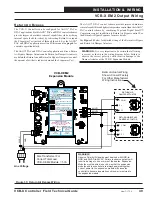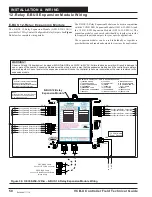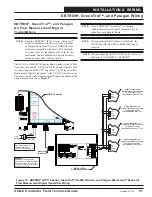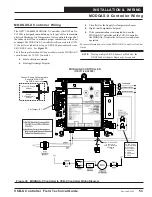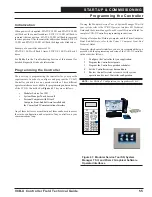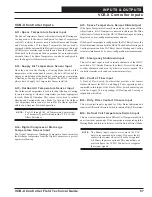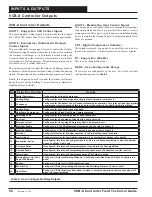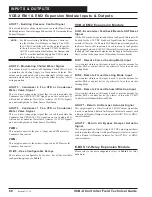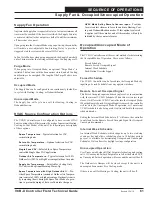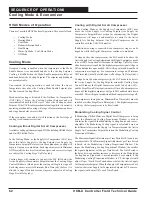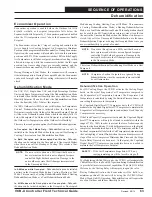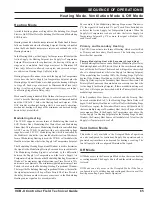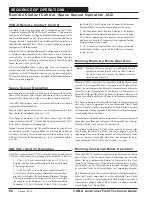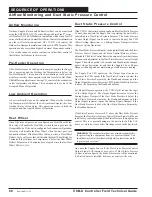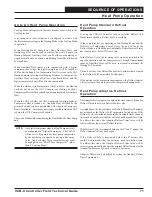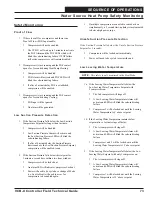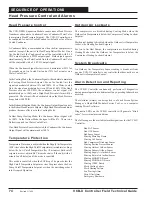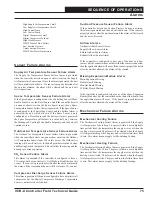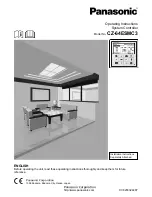
Zone
Zone
SEQUENCE OF OPERATIONS
VCB-X Controller Field Technical Guide
62
HVAC Modes of Operation
There are 7 possible HVAC Modes of Operation. They are as follows:
•
Cooling Mode
• Heating Mode
•
Vent Mode
•
Dehumidi
fi
cation Mode
• Heat Pump
• Warm-Up Mode / Cool-Down Mode
• Off Mode
Cooling Mode
Occupied Cooling is enabled when the temperature at the Mode
Enable Sensor rises one deadband above the Cooling Setpoint.
Cooling is disabled when the Mode Enable temperature falls one
deadband below the Cooling Setpoint. The setpoint and deadband
are user-adjustable.
Unoccupied Cooling operation is enabled when the Space
Temperature rises above the Cooling Mode Enable Setpoint plus
the Unoccupied Cooling Offset.
Mechanical cooling is disabled if the Outdoor Air Temperature
(OAT) falls 1° below the Cooling Lockout Setpoint and will
remain disabled until the OAT rises 1° above the Cooling Lockout
Setpoint. If the OAT disables mechanical cooling while it is currently
operating, mechanical cooling will stage off as minimum run times
and stage down delays are satis
fi
ed.
If the economizer is enabled, it will function as the
fi
rst stage of
cooling (see Economizer section).
Cooling without Digital Scroll Compressor
Available cooling options are staged DX, Modulating Chilled Water,
and On/Off Chilled Water.
In the Cooling Mode, as the Supply Air Temperature (SAT) rises
above the Active Supply Air Cooling Setpoint (see Supply Air
Temperature Setpoint Reset section for explanation), cooling will
begin to stage on or to modulate. Each stage must meet its Minimum
Off Time (adj.) before it is allowed to energize, and successive stages
are subject to a Cooling Stage Up Delay (adj).
Cooling stages will continue to run until the SAT falls below the
Active Supply Air Temperature Setpoint minus the Cooling Stage
Control Window at which point the cooling will begin to stage off.
Each stage must meet its Minimum Run Time (adj.) before it is
allowed to stage off and successive stages are subject to a Cooling
Stage Down Delay (adj.).
Cooling with Digital Scroll Compressor
In the Cooling Mode, as the Supply Air Temperature (SAT) rises
above the Active Supply Air Cooling Setpoint (see Supply Air
Temperature Setpoint Reset section for explanation), the Digital
Compressor will stage on and modulate to control to the Active
Supply Air Cooling Setpoint. One Digital Compressor can be
controlled with the VCB-X Controller.
If additional cooling is required,
fi
xed compressor stages can be
staged on while the Digital Compressor continues to modulate.
To stage up the extra compressor(s), the SAT needs to be above the
Active Supply Air Cooling Setpoint and the Digital Compressor needs
to be at 100% for a period of time equal to the Stage Up Delay. Once
a
fi
xed compressor is enabled, the digital compressor signal will go to
50% and modulate up as needed. This will repeat as additional
fi
xed
compressors are staged up. For compressors to stage on, Minimum
Off Times (adj.) must be satis
fi
ed as well as Stage Up Delays (adj.).
To stage down the extra compressor(s), the SAT needs to be below
the Active Supply Air Cooling Setpoint minus the Cooling Stage
Control Window, the Digital Compressor needs to be below 30%,
and the Stage Down Delay requirement met. Once a
fi
xed compressor
stages off, the digital compressor will go to 50% and modulate down
as needed. This will repeat as additional
fi
xed compressors stage off.
For compressors to stage down, Minimum Run Times (adj.) must be
satis
fi
ed as well as Stage Down Delays (adj.). The digital compressor
is always the last compressor to be deactivated.
Modulating Cooling Signal Control
If Modulating Chilled Water or a Digital Scroll Compressor is being
used, the Modulating Cooling Proportional Window is used to
determine the signal to the Modulating Cooling Source and is user-
adjustable. The Modulating Cooling signal is calculated based on
the differential between the Supply Air Temperature and the Active
Supply Air Temperature Setpoint based on the Modulating Cooling
Proportional Window.
The Maximum Signal Adjustment per Time Period is 10% and is not
user-adjustable. The Minimum Signal Adjustment per Time Period
is based on the Modulating Cooling Proportional Window. The
larger the Modulating Cooling Proportional Window, the smaller
the signal adjustment will be per Time Period. The Time Period is
the delay between another increase or decrease in the Modulating
Cooling Source Signal and is user-adjustable. For example, if the
Modulating Cooling Proportional Window is 5°F, the signal would
adjust 2% per °F each Time Period above or below the Active Supply
Air Temperature Setpoint. When the Supply Air Temperature is above
or below the Active Supply Air Temperature Setpoint by 5°F or more,
the signal would adjust 10% each Time Period.
Cooling Mode & Economizer


